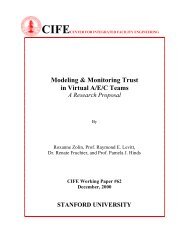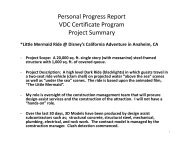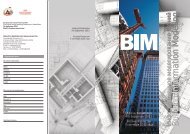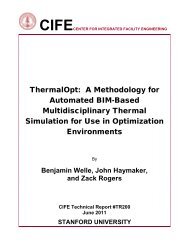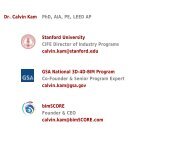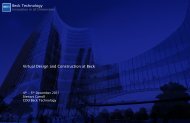Framework for Measuring Rationale Clarity of AEC Design Decisions
Framework for Measuring Rationale Clarity of AEC Design Decisions
Framework for Measuring Rationale Clarity of AEC Design Decisions
You also want an ePaper? Increase the reach of your titles
YUMPU automatically turns print PDFs into web optimized ePapers that Google loves.
<strong>Framework</strong> <strong>for</strong> <strong>Measuring</strong> Rational <strong>Clarity</strong><br />
Page 7 <strong>of</strong> 22<br />
began <strong>for</strong>mally modeling design rationale decades ago to deal with “wicked” problems that have<br />
many complex interactions but little known structure (Rittel and Webber 1973). The seminal<br />
design rationale representation, Issue-Based In<strong>for</strong>mation System (IBIS), was built to help<br />
designers clarify and communicate design and planning <strong>for</strong> such problems. IBIS consists <strong>of</strong> a<br />
network <strong>of</strong> related textual statements: issues, positions regarding issues, and arguments <strong>for</strong> or<br />
against positions. The overall success <strong>of</strong> semi<strong>for</strong>mal design rationale in industry has been<br />
decidedly mixed (Fischer et al. 1991). Research and practice has found IBIS “too simple and<br />
homogeneous… to support decision making in the presence <strong>of</strong> change … (these original<br />
methods) tend to ossify and become impossible to revise or extend” (Potts 1995). While explicit<br />
design rationale “reduces the chances <strong>of</strong> missing some important consideration (Fischer et al.<br />
1991),” it also relies upon decision makers to realize the existence and relevance <strong>of</strong> that<br />
in<strong>for</strong>mation. Without structure, “the (design rationale) document can grow into an unwieldy<br />
amount <strong>of</strong> loosely organized textual in<strong>for</strong>mation… repeated occurrences <strong>of</strong> an issue will usually<br />
be worded and even conceived <strong>of</strong> differently (and) the (design rationale) document will grow to<br />
contain inconsistent in<strong>for</strong>mation (Conklin and Burgess-Yakemovic 1991).”<br />
Structure-Oriented <strong>Design</strong> <strong>Rationale</strong><br />
Research has addressed perceived deficiencies in process-oriented design rationale by leveraging<br />
knowledge about the structure <strong>of</strong> design work. For example, some models explicitly articulate<br />
design goals (Lee and Lai 1991; McLean et al. 1991), or incorporate industry-specific design<br />
methods (Potts 1995). A structure-oriented design rationale “emphasizes the careful construction<br />
<strong>of</strong> (design rationale) as a map <strong>of</strong> the design space and focuses on a rigorous and logical<br />
representation <strong>of</strong> the rationale. This approach maximizes the pay<strong>of</strong>f <strong>of</strong> (design rationale)<br />
through its reuse and/or through lowering the cost <strong>of</strong> system maintenance (Conklin and Burgess-<br />
Yakemovic 1991).” McLean et al. (1991) provide an example <strong>of</strong> structure orientation.<br />
Acceptance <strong>of</strong> design rationale depends upon its match to existing process. However, theory<br />
does not yet contain a definition <strong>of</strong> the components <strong>of</strong> design rationale, or the clarity <strong>of</strong> that<br />
rationale, suitable to match to <strong>AEC</strong> processes.<br />
<strong>Rationale</strong> clarity framework (RCF)<br />
Moran and Carroll (1996) ask, “How far can we characterize the structure <strong>of</strong> design abstracted<br />
from specific domains?” This section builds on decision and organization theories to structure a<br />
<strong>for</strong>mal definition <strong>of</strong> <strong>Clarity</strong> <strong>of</strong> <strong>AEC</strong> <strong>Design</strong> Decision <strong>Rationale</strong>. Projects generate numerous<br />
materials to support design choices, including rhetorical arguments, references to building codes,<br />
and design models. Each <strong>of</strong> these materials provides numerous individual claims that are<br />
relevant to the design rationale, called assertions. This section defines the RCF’s two views.<br />
The first view is that each assertion addresses one or more <strong>of</strong> a set <strong>of</strong> components that span the<br />
necessary and sufficient in<strong>for</strong>mation to explain design decisions. This section explains how<br />
these components follow from the organization <strong>of</strong> <strong>AEC</strong> design and from theories describing the<br />
fundamental requirements <strong>of</strong> decision-making. The second view is that each assertion in a<br />
rationale satisfies conditions <strong>of</strong> clarity. This section provides a way <strong>of</strong> describing the project<br />
team’s achievement <strong>of</strong> clarity in design rationale by defining and comparing several definitions<br />
<strong>of</strong> clarity from literatures such as linguistics, logic, and organizational theory. For example, the<br />
decision matrix presented in Figure 1 encodes assertions such as, “Choosing the steel structure<br />
scores a 2, meaning ‘much better,’ <strong>for</strong> project duration.” The assertion regards the analysis<br />
©2010 John Chachere & John Haymaker




